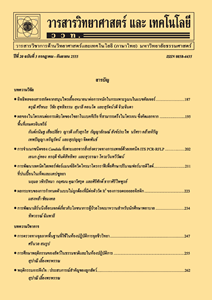ผลของโพแทสเซียมต่อปริมาณผลผลิต การสะสมธาตุอาหารในเนื้อเยื่อปริมาณน้ำตาล และการยอมรับของผู้บริโภค ต่อมะละกอที่ปลูกในวัสดุปลูก
Main Article Content
Abstract
บทคัดย่อ
การศึกษาผลของธาตุโพแทสเซียมต่อปริมาณผลผลิต การสะสมธาตุอาหารในเนื้อเยื่อ ปริมาณน้ำตาล และการยอมรับของมะละกอพันธุ์ปากช่อง 2 ที่ปลูกในวัสดุปลูกโดยเปลี่ยนความเข้มข้นโพแทสเซียมในสารละลายธาตุอาหาร 4 ระดับคือ 100, 200, 300 และ 400 ppm พบว่า ต้นที่รดด้วยสารละลายธาตุอาหารที่มีโพแทสเซียมความเข้มข้น 400 ppm และ 300 ppm ให้จำนวนผลผลิตที่ไม่แตกต่างกันทางสถิติ (p>0.05) แต่มากกว่าต้นที่รดด้วยสารละลายธาตุอาหารที่มีโพแทสเซียมความเข้มข้น 200 ppm และ 100 ppm การวิเคราะห์ปริมาณน้ำตาลในผลมะละกอสุกพบว่า โพแทสเซียมมีผลต่อปริมาณน้ำตาลและพบปริมาณกลูโคสมากกว่าฟรุค-โตสเล็กน้อย การศึกษาปริมาณธาตุอาหารไนโตรเจน ฟอสฟอรัส โพแทสเซียม แคลเซียม และแมกนีเซียม ที่สะสมในเนื้อเยื่อใบ ก้าน ผลดิบและผลสุกของมะละกอ พบว่าใบเป็นส่วนที่ใช้ธาตุอาหารเกือบทุกตัวมากที่สุด สำหรับธาตุโพแทสเซียมจะพบปริมาณสะสมมากในเนื้อเยื่อทุกส่วนของมะละกอ และพบมากที่สุดที่ก้านใบ นอกจากนี้ผลการทดสอบการยอมรับของผลมะละกอสุกโดยใช้ผู้บริโภคเป้าหมายจำนวน 100 คน พบว่า ทุกตัวอย่างมีคะแนนการยอมรับโดยรวมไม่แตกต่างกันทางสถิติ (p>0.05) อย่างไรก็ตามมะละกอที่รดด้วยสารละลายที่มีโพแทสเซียมความเข้มข้น 100 ppm มีคะแนนการยอมรับด้านความหวาน ความแข็ง และความฉ่ำน้ำขณะเคี้ยวน้อยกว่าตัวอย่างอื่นๆ (p<0.05)
คำสำคัญ : โพแทสเซียม; มะละกอ; ระบบปลูกแบบไม่ใช้ดิน; ผลผลิต; ปริมาณน้ำตาล; การยอมรับ
Abstract
Effects of four different concentrations of potassium (100, 200, 300 and 400 ppm) on yield, accumulation of nutrient in tissues, sugar content and consumer acceptance of papaya (Carica papaya) grown under substrate culture were investigated. The results indicated that fruit yield of papaya trees treated with nutrient solution containing 400 and 300 ppm of potassium concentration was not significantly different but was higher than those treated with 200 and 100 ppm of potassium concentration. The analysis of sugars content in ripe papaya showed that potassium affected sugar quantity in ripe papaya and glucose was found at slightly higher concentration than fructose. The quantitative analysis of nitrogen, phosphorus, potassium, calcium and magnesium accumulated in leaf, leaf stalk, raw papaya and ripe papaya indicated that most nutrients were found in leaf. However, high concentration of potassium was accumulated in all tissues and the highest concentration was in leaf stalk. In addition, results from acceptance test using 100 target consumers indicated that overall acceptance scores of all ripe papaya samples were not significantly different (p>0.05). However, acceptance scores for sweetness, firmness, and juiciness of papaya treated with 100 ppm of potassium concentration were significantly less than those treated with higher potassium concentrations (p<0.05).
Keywords: potassium; papaya; substrate culture; yield, sugar content; acceptance


